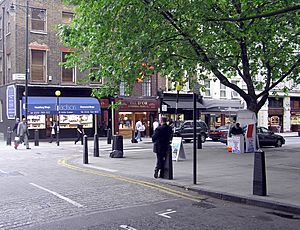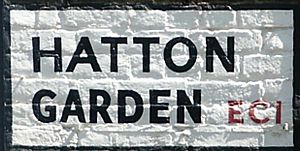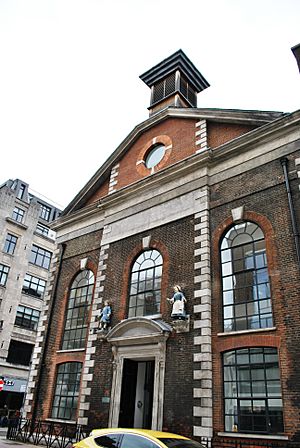Hatton Garden facts for kids
Hatton Garden is a famous street and business area in Holborn, a part of London. It's very close to the City of London. The street is named after Sir Christopher Hatton. He was a favorite of Queen Queen Elizabeth I. He built a large house here and took over the garden and orchard of Ely Place. This was once the London home of the Bishops of Ely. Hatton Garden stayed with the Hatton family. Later, it became a fancy place to live during the time of King King Charles II.
St Etheldreda's Church is in Ely Place. It's one of only two buildings in London from the time of King Edward I. This church is one of the oldest in England still used for Roman Catholic worship. Another old building, now called Wren House, was once an Anglican church. It was later used by a charity school. Statues of a boy and girl in uniform were added to it.
Hatton Garden is known as London's jewellery quarter. It is the main place for the diamond trade in the United Kingdom. This special focus on jewellery began in the early 1800s. It grew from an older jewellery area nearby called Clerkenwell. Today, there are almost 300 jewellery businesses here. There are also over 90 shops. This makes it the biggest group of jewellery shops in the UK. One of the biggest diamond companies, De Beers, used to have its main office here.
Sir Hiram Maxim had a small factory at 57 Hatton Garden. In 1881, he invented the Maxim Gun there. This was an early machine gun. It could fire 666 rounds in one minute! Hatton Garden has many underground vaults, tunnels, and workshops. Today, the area is also home to many media, publishing, and creative companies. Some nearby streets, like Hatton Place and Saffron Hill, have been improved. They now have modern apartments.
Contents
The Story of Hatton Garden
The Hatton Garden area was developed between 1659 and 1694. It became a new place for people to live. This happened after the Restoration period in England. It was built soon after other new areas like Covent Garden.
Before this, the land belonged to the Bishops of Ely. They had a medieval palace, gardens, and an orchard there. In the 1570s, Sir Christopher Hatton got a lease for part of the land. He built Hatton House. Later, he got full ownership from Queen Elizabeth I. After he died, the land went to his family.
During the English Civil War, the palace was damaged. In 1659, a new street, Hatton Street (now Hatton Garden road), was started. Builders began to construct tall, spacious houses. These houses were for rich people. They wanted homes in London.
The area grew with a grid of new streets. By 1666, the year of the Great Fire, many houses were built. The Great Fire did not reach Hatton Garden. After Lord Hatton died in 1670, the northern part of the area was finished by 1694. Many important people lived here early on.
Where Street Names Come From
Many street names in Hatton Garden tell a story about the past. Here are some of them:
- Baldwins Gardens – Named after Richard Baldwin. He was a gardener for Queen Elizabeth I.
- Beauchamp Street – Comes from Beauchamp Court. This was the birthplace of Fulke Greville, 1st Baron Brooke.
- Bleeding Heart Yard – People think this name came from an old pub sign.
- Brooke Street – Named after Fulke Greville, who owned a house nearby.
- Charterhouse Street – This name comes from "Chartreuse." It refers to a French monastery.
- Clerkenwell Road – Named after a local well. This well gave its name to the whole area.
- Dorrington Street – A changed version of 'Doddington'. This was the name of Anne Doddington.
- Ely Court and Ely Place – Named after the Bishops of Ely. They owned this land before 1659.
- Farringdon Road – Named after Sir William or Nicholas de Farnedon. They were local leaders in the 1200s.
- Gray's Inn Road – Named after Lord Gray of Wilton. He owned a building here that lawyers later used.
- Greville Street – Also named after Fulke Greville.
- Hatton Garden, Hatton Place and Hatton Wall – All named after Sir Christopher Hatton.
- Holborn – Thought to come from ‘hollow bourne’. This means the river Fleet which flowed in a valley nearby.
- Kirby Street – Named after Christopher Hatton's home, Kirby Hall.
- Leather Lane – This name might come from an old English personal name, Leofrun.
- Leigh Place – Named after the Barons Leigh. They bought land here in 1689.
- Portpool Lane – Thought to be from ‘Purta's Pool’.
- Saffron Hill and Saffron Street – These used to be gardens where the Bishops of Ely grew saffron.
- St Cross Street – Was originally Cross Street. The 'St' was added in 1937 to avoid confusion.
- Verulam Street – Named after Francis Bacon. He was a lawyer and philosopher.
- Viaduct Buildings – Named because they are next to Holborn Viaduct.
- Waterhouse Square – Named after Alfred Waterhouse. He was the architect of a building nearby.
Hatton Garden in Stories
Hatton Garden has appeared in many books and TV shows:
- The comedians Michael Flanders and Donald Swann sang about Hatton Garden. Their song "Down Below" mentions a diamond dropped down a drain.
- In Evelyn Waugh's novel Brideshead Revisited, a character buys an engagement ring here.
- The children's novel Smith by Leon Garfield features Hatton Garden. The main character tries to escape through its streets.
- In Ian Fleming's novel Diamonds Are Forever, James Bond visits a fictional diamond shop here.
- The street name appears in the Poldark book series by Winston Graham.
- An episode of The Avengers TV show is set in Hatton Garden's diamond business.
- The diamond robbery in the film A Fish Called Wanda happens in Hatton Garden.
- The 1924 mystery novel Inspector French's Greatest Case also takes place in this area.
Images for kids






